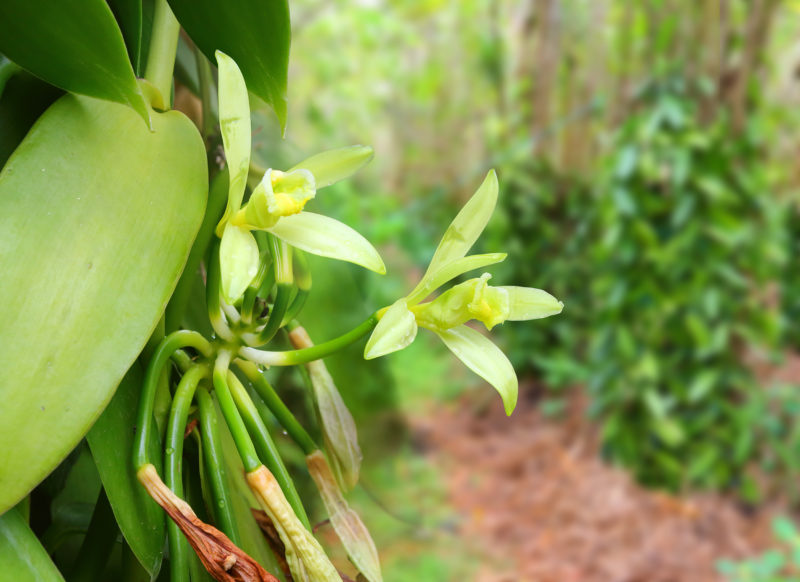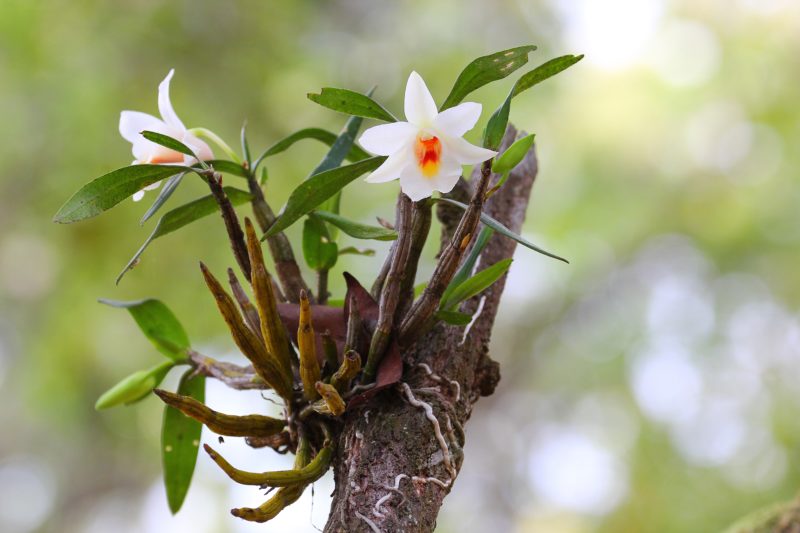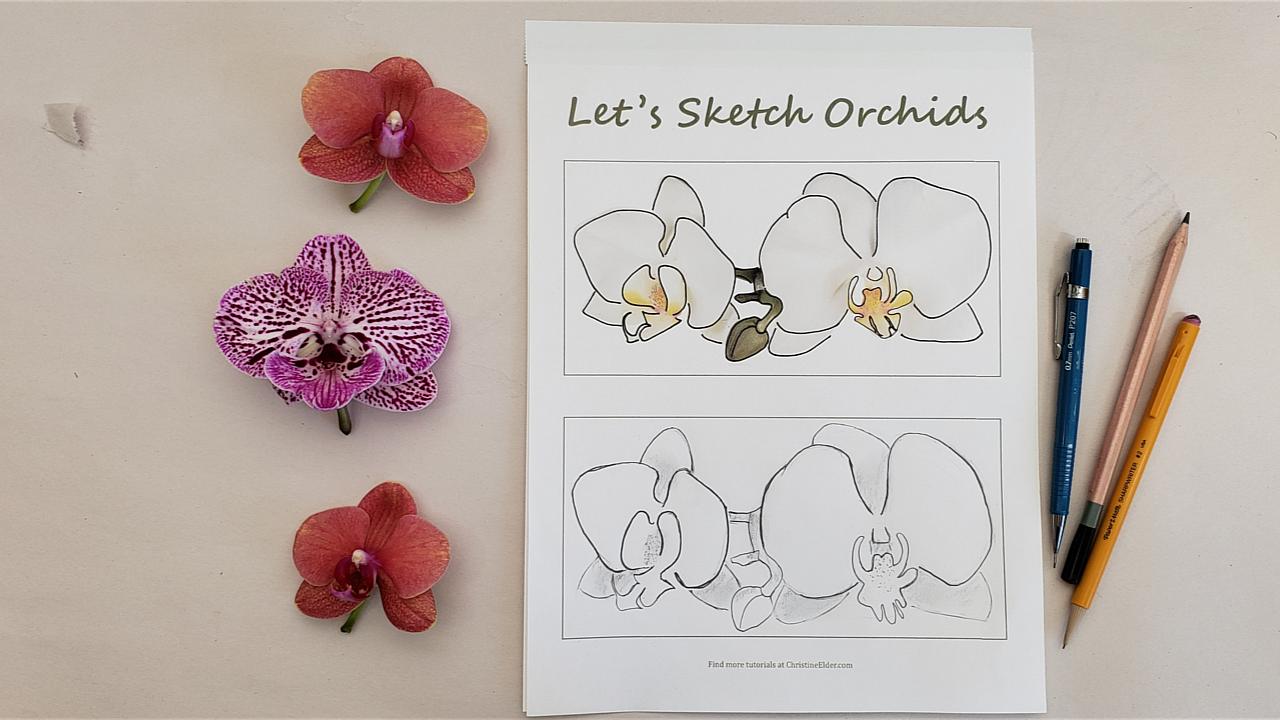National Orchid Day
April 16th is designated as National Orchid Day in the United States. Below you’ll find information about orchids of North America and the world, unique characteristics of the orchid family, a slideshow of orchids from my trip to the tropical rainforests of Borneo, a video tutorial about orchid flower anatomy and how to sketch them, some tips on growing orchids and resources for learning more about orchid biology and conservation.
And I even include my ‘secret’ recipe for making homemade vanilla extract, which of course is derived from an orchid!
Introduction to Orchids
Scientists have discovered over 28,000 species of orchids in the world, and over 300 are native to North America alone! They are the 2nd largest family of flowering plants, with over 700 genera. Contrary to popular belief, wild orchids are not confined to the wet and steamy tropics but are found from Patagonia to the Arctic Circle, in all habitats and elevations.
Why some Orchids are Endangered
Many species of the world’s wild orchids are threatened with extinction. Here are a few of the reasons:
- Loss of habitat from human development; rainforests, wetlands and meadows where orchids live are being destroyed and converted to plantations, housing tracts, roads, dams, mines, and other industrial uses.
- Climate change; changes in earth’s temperatures affect rainfall, seasons, and extreme weather events and thus change the life-cycles of orchids, their host plants, their pollinators and the mycorrhizal fungi they depend upon. CLICK HERE for an example.
- Forest fires; both natural and those started by humans or caused by climate change destroy orchid habitats.
- Clearcutting of rainforests; many of the world’s orchids are native to tropical as well as temperate rainforests and live as epiphytes among the branches of tall trees.
- Loss of pollinators; many species of orchids have a tight-knit, 1-on-1 relationship with a pollinating insect and if it goes extinct, so can the orchid upon which it depends.
- Trampling; from both humans and from livestock when grazing in meadows, grasslands, and prairies where orchid live.
- Illegal collecting; orchids are protected in many countries but are still poached from the wild for the horticultural trade, traditional medicinal uses, and private collections.
What Makes the Orchid Family Unique?
You are surely familiar with what orchids look like and have likely had many experiences with them throughout your life, whether it was wearing an orchid corsage for your high school prom, receiving a potted orchid plant for a special occasion or being lucky enough to see one growing in the wild.
But what are orchids really? Here are some defining characteristics of the Orchid family, starting with their most unique feature; their flowers.
Unique Qualities of Orchid Flowers
• Orchids have a unique flower in which the male and female reproductive parts are fused into a structure called the column and the pollen grains are fused into a sticky pollinium that attaches to the head of a pollinating insect as it seeks nectar in the flower. A college botany professor of mine once said “by their fruits ye shall know thee”, meaning that the anatomy of a plant’s flowers, fruits and seeds will give away their identity and this is certainly true of orchids.
• Their flowers are showy and colorful with bright colors or patterns on both their 3 sepals and 3 petals. Some have even evolved to mimic the female of certain bee species in order to trick the male into visiting and pollinating the flower.
• One of the 3 petals is highly modified into a lip-like structure that serves as a landing platform and visual attractant for the plant’s pollinators.
• Many orchid species having beguiling fragrances to attract their pollinators as well as human admirers.
• Individual flowers on an orchid plant can sometimes last for months, which is one of the reasons they are so popular as ornamental house plants. Depending upon the species, an orchid may sport one single showy flower or an inflorescence of numerous tiny flowers as small as your pinkie fingernail.
• Orchid flowers produce the world’s smallest seeds that you may recognize as the tiny black dots in traditional vanilla ice cream! In order to germinate, seeds require nutrients supplied by a mycorrhizal relationship with a specific fungus that lives naturally in the soils of their native habitats.
- An orchid flower matures into a fruit or seed pod, which may contain millions of dust-like seeds
Other Characteristics of the Orchid Family
• Orchids are perennials, growing slowly and living many years.
• The leaves of orchids plants are simple in shape, without any lobes and have parallel veins.
• Many tropical orchids grow as epiphytes high in the branches of rainforest trees. These species often have enlarged water retaining bulbs at their bases and aerial ‘basket’ roots.
• Most temperate species are terrestrial, growing in wetlands, meadows, or cliff sides.
• Orchids are dependent upon symbiotic mycorrhizal fungi that enable their seeds to sprout and their roots to gain nutrients. In return, the fungi receive a steady supply of carbohydrates from their orchid companion’s photosynthesizing leaves.
Famous Orchids
Darwin’s Orchid
Charles Darwin was fascinated by orchids and their highly modified floral structures which suggested to him a possible co-evolution with their insect pollinators. The flower of Darwin’s orchid, Angraecum sesquipedale, a native of Madagascar has an astonishing foot-long nectar spur, which led Charles Darwin to suggest that this species was pollinated by a moth with a proboscis of a similar length.
His theory was validated when the pollinator was finally discovered, over 20 years later, after Darwin’s death. Fittingly the moth was first named ‘the predicted one’ and later known as Darwin’s Moth or Morgan’s Sphinx Moth. Below you’ll see illustrations of the orchid as it was observed in the 1860s, including an illustration of the as yet undiscovered moth that Darwin predicted to be its pollinator.
The Vanilla Orchid
People are familiar with vanilla as a food flavoring, but many don’t realize that it is derived from the seed pods of an orchid, Vanilla planifolia native to Central America, where it had been used and cultivated for centuries before Columbus arrived. Today it is grown commercially here as well as in the Caribbean, Madagascar, and French Polynesia. The astronomical expense of pure vanilla extract (see my recipe farther down this page!) is due to the labor-intensive growing methods and the fact that it must be hand pollinated.
Orchids As National Flowers
Colombia’s National Flower,Cattleya trianae, is a species of orchid that inhabits cloud forests at 1500–2000 meters above sea level. It is an endangered species due to habitat destruction. The lip of the flower shares the same colors as the national flag. The species was named after the 19th-century Colombian botanist José Jerónimo Triana.
Other countries have native orchids as their national flower including Brazil, Belize, Costa Rica, Guatemala, Honduras, Singapore, and the Seychelles!
How to Grow Orchids
Many species of orchids are easily obtained from nurseries and are readily grown as house plants. Since the orchid craze began in 19th-century Victorian England, horticulturalists have developed more than 100,000 hybrids and cultivars of orchids including those of Cattleya, Phalaenopsis, Paphiopedilum, Oncidium, Cypripedium, Cymbidium, Dendrobium, and even Vanilla (yes, it’s an orchid too!)
I’m quite successful at getting my orchids to not only survive after bringing them home from the nursery but also getting them to rebloom. So, folks always ask what my secret is, and I say “Benign Neglect”, meaning not too much water, heat or soil (and NEVER put in direct sunlight). Also, I always re-pot them after they’re done blooming in a custom mixture of orchid bark, sphagnum moss, charcoal, and perlite. Frankly, my orchids love it when I’m traveling, because that’s the ultimate in neglect. Each time I arrive back home, I invariably find at least one of my plants has sprouted a blossoming stem.
Tips for Growing Orchids
I find that most indoor orchids thrive best in the following conditions:
- Do not put orchid plants in direct sunlight but do provide them with plenty of bright indirect sunlight.
- Do not overwater! Water only every 10 days or so, and only if the soil is dry to the touch. I take my orchids out of their decorative ceramics pot and water them in the sink, letting them drain well before putting them back.
- They can usually handle normal indoor temperatures but avoid areas exposed to drafts or direct heat from furnaces. They enjoy being in a spot where the temperature drops a bit at night, which will help them rebloom.
- Orchids enjoy humidity, so consider putting them in the bathroom or kitchen. That said, my orchids do pretty well even though I live in the dry desert air of central Oregon. Some species do better than others with low humidity depending upon the conditions in their native habitat.
- You might consider fertilizing but it’s easy to overdo it and burn them. The mantra is ‘weekly weakly’ meaning give a very diluted solution to your plants on a weekly basis. I don’t usually fertilize and they still rebloom.
- Re-pot your orchids after they’re done blooming. I blend up a custom mixture of orchid bark, sphagnum moss, charcoal, and perlite. Don’t plant orchids in regular soil, it’s too fine-grained and compact to allow for adequate aeration and drainage since the quickest way to kill an orchid is to let it get water-logged. You can easily purchase orchid potting mix from home and garden stores. It’s a shame that so many folks just throw their orchids away after they’ve bloomed with the false notion that it’s difficult to get them to rebloom. Not true! I’ve had several of my orchid plants for 10 years and they continue to bloom at least twice a year.
- Some growers advise you to cut off the bare flowering stem after the flowers have wilted but I disagree. My plants often sprout new flowering shoots from those old stems so I say, leave em!
Orchid Growing Tips
Here are a few of my tips for growing orchids.
How to Make Vanilla Extract
I love to make my own homemade vanilla extract, which is actually pretty easy. Whenever I travel to Mexico I purchase some vanilla beans, but you can easily find them in your local specialty grocery store. Then buy a high-quality bottle of vodka, preferably from a local distillery. I use Crater Lake Vodka from BendDistillery. Then get a food-grade glass jar, preferably with dark glass to protect the contents from sun damage. Next cut about 5 vanilla beans lengthwise to expose their inner flesh then into 1-inch slices and put them in the jar with a cup of the good vodka. Put on a cool, dark shelf in the kitchen and wait a few months. Viola, you now have authentic vanilla extract you can now use to flavor your favorite desserts!
Adventures with Orchids
I’ve been lucky to see native orchids throughout the US, from Alaska’s Calypso Orchid to Florida’s endangered Ghost Orchid. My international travels have taken me to see orchids in Mexico, Guatemala, the Caribbean, Honduras, Peru, and Borneo. I’ve created this short video for you as just a quick taste of orchid diversity seen on a to Borneo; an island known to support at least 3,000 species. Enjoy!
How to Draw Orchids
CLICK HERE to watch my one-hour video tutorial that teaches you lots of cool orchid facts and leads you through a step-by-step tutorial on how to draw one.
Learn More about Orchids
Below you’ll find some resources for learning more about orchids, their biology, conservation, and cultivation.
- If you’d like to learn more about orchids and their cultivation, I’d start at the American Orchid Society.
- If you’re in the US, you may enjoy this website; The North American Orchid Conservation Center.
- The U.S. Fish and Wildlife Service ‘s orchid information page.
- International Union for the Conservation of Nature‘s orchid information page.
- Online key to identifying North American Orchids where you can find picture keys to native orchids in your state of the U.S.
- Check out the Orchid Recovery Program to learn about research on conservation.
- Learn how to Grow Orchids.
- For a comprehensive book on orchids, look no further than The Orchids: Natural History and Classification (1981, 1990), by Robert L. Dressler.

Did You Enjoy This Story?
If you’ve found value in this story and believe in my mission to educate youth and adults alike on the value of nature, I invite you to make a donation to help broaden and deepen the work I can accomplish.
Click the Paypal ‘Donate’ button below to donate any amount you wish to support the conservation and education work I do. You don’t need to have a Paypal account to donate, you may also choose to use a credit card, or simply send put a check in the mailbox if you wish. Thank you!



















